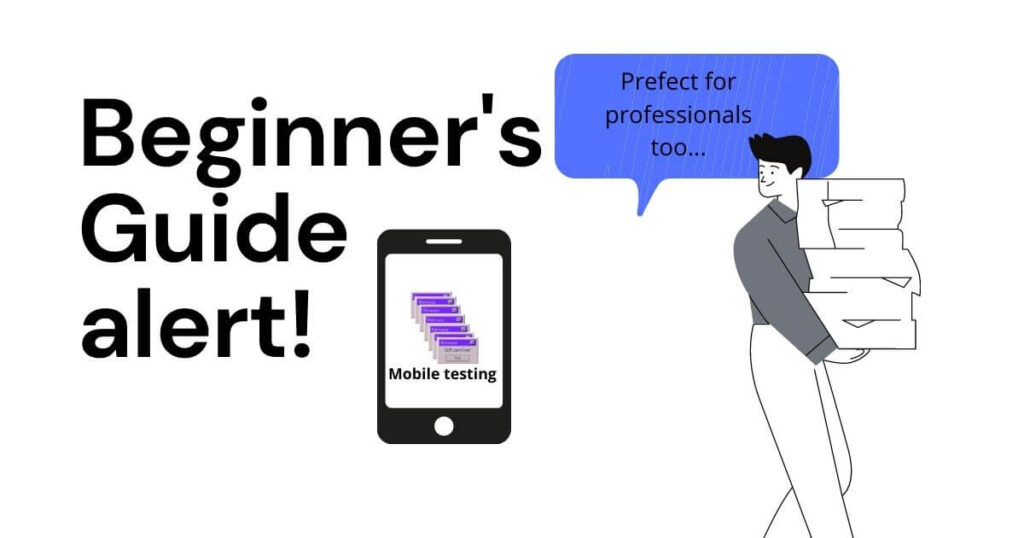Before we jump into the introduction to Mobile App Testing here’s what is happening in the tech world right now. Mobile. This word really needs no introduction but requires a special mention of how it’s dominating the tech world. This range of popularity also brings responsibility to several tech professionals like software developers and testers.
This blog will help you know yours if you are keen on finding the right quality and business conversions. The content in the blog is the introduction to mobile testing, and you shall see several versions of it coming in the future, so it becomes a complete guide to mobile testing. Well, it’s a complete beginner’s friendly. So, let’s get straight to the blog.
1. Why is mobile such a big tech shift when you have a desktop?
You see, that’s a good question. People, professionals, and everyone don’t like to open their laptops for everything, and you don’t like to carry them with you everywhere. That doesn’t mean you don’t need desktops; no, we’ll be needing them a lot.

Hence, your clients will be happy if you offer services and the good job you are doing even on mobile. And for which you definitely need an excellent testing infrastructure. Sure, we’ll learn all of them.
2. Types of Mobile Testing that you must know:
Mainly 2 types of mobile testing, and they are super prominent. Here they are:
- Hardware Testing:
It is also called Mobile Testing, in which you test the internal processors, cameras, memory of the device, Bluetooth, resolution, radio, etc.
- Software or Application Testing:
For the most part and even almost, this blog will focus on mobile software or application testing. Here you test the functionality of the applications that are created to work on mobile devices. One thing to note is that even in mobile applications, some fundamentals separate one from another, and you must know how they are different.
- Native applications: These apps are developed to operate on devices like smartphones and tablets.
- Mobile web applications: These apps are server-side apps that run on the browsers of your mobile device when connected to a mobile network or WIFI; browsers like Chrome, Firefox, and more.
- Hybrid applications: These apps are a mix of both native and web applications. They would fairly run offline and are developed using HTML and CSS.
Also read: 6 Test Automation Challenges That Won’t Let You Own Its Full Efficiency
A few more things that differentiate these three and also mark them out:
- Native applications possess a single platform affinity, whereas mobile web applications possess cross-platform affinity.
- As said earlier that native applications are written using web technologies like HTML, CSS, or asp.net, PHP, etc. mobile web applications are written using platforms like SDKs.
- There requires an installation process for native applications but for mobile web applications; it’s not.
- There is something called centralized updates for mobile web applications, whereas you can update a native application via the play store or app store.
- You definitely need an internet connection for using web applications but for a few native applications; you may not necessarily be needing it.
- Because of this reason, as mentioned earlier, the native application works a little faster than the web applications because of the reason.
- You can install the native from the app stores just like the Google play store or app store.
- Now when it comes to mobile web applications, they solely need an internet connection.
Furthermore, we’ll learn about mobile application Testing. Well, let’s know its importance.
3. Why the Mobile Application Testing is so important
Let’s clear the air; mobile application testing is tougher than the general web application testing on the desktop. And it’s due to the following reasons.
- Various varieties of mobile devices are available in the market right now, and because they come in different screen sizes and hardware, it’s indeed challenging.
- Talking about the variety, here are some examples: we have HTC, Samsung, Apple Nokia, and more.
Several varieties of the operating system include the famous Android, Windows, Blackberry, IOS, Symbian, and more. - Then comes the various operation system versions like the iOS 5.x, iOS 6.x, BB5.x, BB6.x, and several others.
- Further, there are many different mobile network operators like GSM, CDMA, and more.
- And last but not least the frequent updates, and on top of that, there needs a new testing cycle to ensure every application’s functionality is on track and not affected.
Addressing the difficulties in the road to good quality is to say that testing is quite a priority in fact a big one. Application, be it small or big, testing for every app is essential. Think this way, you are finally on the google play store, and potentially many might need your service, which makes money for you. And they wouldn’t appreciate anything less than a decent app without bugs.
Now let’s learn some of the fundamental differences between Mobile and Desktop Application Testing.
4. Fundamental Difference Between Mobile and Desktop Application Testing
If you are a strict beginner, this information can boost your basic knowledge and set a practical foundation moving forward. Here we go!
- When we are talking about desktop applications, they are typically tested on a CPU central processing unit. In contrast, mobile applications are tested on handsets like Samsung, Nokia, Apple, HTC, and many.
- The size of the mobile devices is smaller when compared to the desktop.
- The memory on the mobile device is relatively lesser than the memory of a desktop.
- The mobile can use the network connection in 2G, 3G, 4G, 5G, or wifi. But for a desktop, there has to be a broadband connection or dial-up connections.
- The automation tool you use in desktop application testing might not necessarily work on mobile application testing. So, this could be another challenge that you may witness while testing a mobile application.
5. Time for types of Mobile App Testing:
To sum up all the above-mentioned technical aspects, the following testing types are executed with a standard plan on mobile apps.
-
Usability Testing:
Is your app ready for use? How do you know that? By using it, but how do you know if it’s perfect enough? Usability testing. This is done to assure that the user experience on the app is top-notch or at least satisfactory to the customers.
-
Compatibility Testing:
How comfortable the app is on different screen sizes, mobile devices, OS versions, and many are being tested with this particular type. And that too based on the requirements that you set before the tests.
-
Interface Testing:
There can be different buttons, menu options, and other elements like history, settings, navigation, bookmarks on the app, so they all need to be thoroughly tested. A good customer would appreciate a good interface once they install an app that directly or indirectly creates a big impression.
-
Services Testing:
This is usually to test the app online and offline.
-
Low-level Resource Testing:
This is to test the auto-delete of temporary files, the memory usage, then the local database, and if there are any growing problems.
-
Performance Testing:
Performance is key; now, how do we do that if you want to impress any customer? Performance test! One way is by changing the network connection from 2G, 3G, 4G, 5G to wifi and sharing the documents, checking the battery depletion, and many more.
-
Operational Testing:
Things like backups, recovery plans in case the battery is down, data loss when updating the application.
-
Installation tests:
Authentication of the app by installing or uninstalling the app on the devices.
-
Security Testing:
It’s to check the efficiency of the app to protect the data of the customers.
6. Mobile Application Testing Strategy
The Test Strategy is to ensure that the quality of the app meets all the performance standards. We’ll extend a bit more on that.
- Choosing of devices: One best way to figure this out is to pick the popular ones that are mostly used in the market or discuss with your client if they have any specific device they personally want to include.
- Emulators: In the early stages of development, they become so useful because they aid the fast and adequate checking of the app. An emulator is a tool that operates the software from one environment to another without altering the software. It mimics the features and runs on a real-time system.
Some types of a mobile emulator for your reference:
Browser Emulator – Mimics the mobile browser environments.
Device Emulator – they are given by the device manufactures
Operating System Emulators – Apple can offer emulators for iPhones, Microsoft for Windows Phones, and Android devices.
Lastly, stay tuned to the upcoming series of blogs on mobile testing and if you like the type of the content and want to read more do subscribe to our blogs. Follow QA Touch for more interesting testing tech updates and trendy happening in the QA Community. Also you can join us at our social where we have so much fun.







